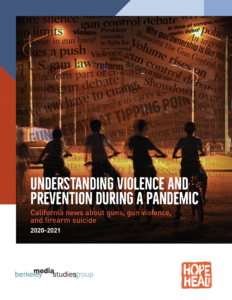How California news about gun violence has evolved amid the pandemic, protests against police brutality, and journalists’ commitments to improve coverage
by: Heather Gehlert
posted on Friday, September 17, 2021
This spring, a group of journalists from a range of news outlets, including The Trace, The Washington Post, and The Guardian, met to discuss how the media can more effectively cover gun violence. Together, they pledged to allocate more time and resources to the issue, make clear its connections to racism and health disparities, and go beyond mass shootings to cover other, more common forms of gun violence.

This commitment comes as advocates have voiced concerns about the extent of our country’s gun violence and firearm suicide crisis, as firearm deaths and injuries have both increased amid the pandemic, with nearly 4,000 additional gun deaths and more than 9,000 additional gun injuries in 2020 than in 2019.
While top public health officials remain focused, understandably, on increasing vaccine access and vaccination rates as COVID-19 continues to ravage communities, reporters and advocates alike want to ensure that gun violence, which has been labeled a health crisis by the American Medical Association and American Public Health Association, still commands the attention it deserves.
The good news, according to a new study from the Berkeley Media Studies Group (BMSG), is that guns and gun violence are garnering significant media attention, with outlets in California increasing their coverage of the issues in recent years.
“It’s encouraging that journalists are taking gun violence seriously and making good on their promises to help the public better understand this major public health issue,” said Pamela Mejia, who leads the research team at BMSG.
Print and online news about gun violence appearing in California media outlets, relative to the total volume of news, increased by 25% in English-language outlets and 60% in Spanish-language outlets in 2020-2021, compared to 2016-2017, researchers found.
The study, part of a larger collaboration between BMSG and the Hope and Heal Fund, revealed several other promising findings:
- news coverage of police violence is on the rise, accounting for much of the total increase in California news about gun violence;
- reporters are increasingly identifying the role of racism in perpetuating violence, with 25% of articles about police violence mentioning “racism” in the lead paragraph; and
- prevention is gaining visibility, with 10% of gun violence news stories addressing prevention in the lead paragraph. This is up from just 3% in our previous analysis.
The BMSG team also explored how firearm suicide, community violence, and domestic violence appeared in coverage, as well as how much visibility gun sales received in the news.
However, more research is needed, and challenges remain for journalists to continue to improve their approach to reporting.
“While it is heartening to see more explicit mentions of racism, police violence, and prevention in the news about gun violence, policymakers and the public still need to hear more about how local solutions can prevent and interrupt gun violence and firearm suicide,” Hope and Heal Fund Director Brian Malte said. “What do solutions look like in practice? What strategies are getting results that could be replicated? How can reporters do more to uplift authentic and trusted community voices?”
Given that California’s population is 40% Latinx, Malte also questioned how journalists can better communicate about gun violence to Spanish-speaking audiences, noting that most of California’s Spanish-language coverage came from a single news outlet: La Opinión.
Malte and Mejia will join others from BMSG and Hope and Heal for a webinar on Thursday, Oct. 7 at 11 a.m. PT (2 p.m. ET) to answer questions; share more research findings; discuss implications for reporters, advocates, and funders both within and outside of California; and talk about next steps for the fields of violence prevention and journalism.
To register for the webinar, visit https://bit.ly/bmsg-report-webinar-oct7.
To request an an interview with a BMSG researcher or member of the Hope and Heal Fund, email info@bmsg.org or info@hopeandhealfund.org.



